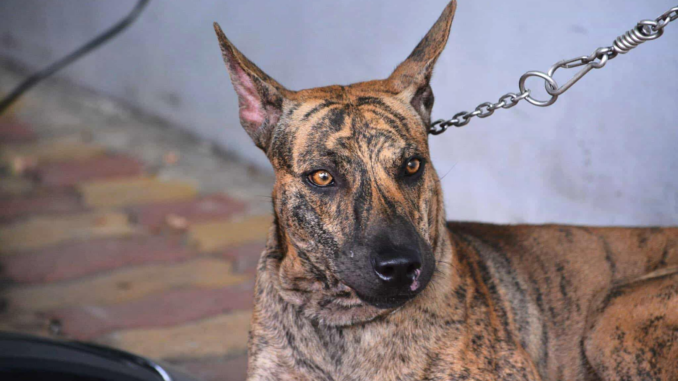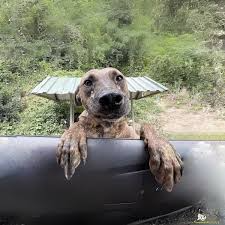
The Heartwarming Story of Rescuing a Neglected Dog: A Journey from Pain to Happiness
Bringing home a dog who has suffered from months of neglect is a deeply emotional and transformative experience, not only for the animal but for you as well. When I first laid eyes on this dog, abandoned, starving, and scarred by past trauma, I never imagined the profound bond we would form. But through patience, love, and consistent care, the transformation was nothing short of miraculous. Here’s how our journey unfolded, and how my dog is now learning to experience happiness after years of struggle.
The First Encounter: A Heartbreaking Sight
When I first found the dog, it was clear that it had been through far too much. Its ribs were visible beneath its matted fur, and its eyes had a hollow, distant look. The poor creature was covered in scars, signs of neglect and possibly abuse. It looked like it had lost all hope, not just physically but emotionally. But there was something in its eyes—a flicker of something that made me believe that, despite all its suffering, there was a chance for healing.
The Reality of Rescue: What it Really Takes to Heal a Neglected Dog
Rescuing a dog who’s been abandoned is far from an easy task. It’s not just about providing food and shelter; it’s about addressing the emotional trauma that comes from months or even years of neglect. These dogs often come with deep scars that can’t be seen on the surface. They may be afraid of new environments, human touch, or even the sounds of a typical home.
But the key to helping them is time, patience, and understanding. It’s crucial to create a space where the dog feels safe and loved, allowing it to heal emotionally, as well as physically.
Step 1: Creating a Safe Space for Healing
The first thing I did when I brought my new companion home was set up a quiet, comfortable space for them to rest. This wasn’t just a matter of giving them a cozy bed; it was about making sure they felt secure and unthreatened. Dogs who have been neglected can become easily startled or anxious, so a calm environment was essential.
Calming Their Fears: Easing the Anxiety of a Traumatised Dog
Traumatized dogs often carry deep fears of abandonment or harm. The key here is gradual exposure to the new world. I avoided overwhelming the dog with too much attention at first, instead allowing it to explore the new space at its own pace. Each time it ventured out from its safe space, I rewarded it with gentle praise and treats. This created a positive reinforcement loop that helped to build trust and reduce anxiety.
Step 2: Proper Nutrition and Health Care
One of the most immediate challenges was addressing the dog’s physical health. Starvation and neglect had left it malnourished and weak. The first few days were crucial for providing the necessary nutrients and medical care. I took the dog to the vet right away, and after a thorough examination, we began the journey of helping it regain strength.
Feeding a Starving Dog: A Step Towards Healing
Feeding a dog that has been underfed for so long requires a careful, monitored approach. Introducing food gradually helps the digestive system adjust and prevents potential issues. Over time, I was able to give the dog more nutritious meals, which helped it gain weight and recover physically.
Step 3: Patience and the Power of Love
While food and shelter were essential, the most important element of the healing process was love. The power of love cannot be underestimated when it comes to helping an abandoned dog heal. From the moment I brought this dog into my life, I made sure it felt a sense of belonging.
Love and Trust: Building a Bond with a Traumatized Dog
Trust takes time to build, especially with a dog that has been hurt in the past. In the early days, the dog was hesitant to approach me, often retreating when I moved too quickly. But I didn’t push it; I let it come to me on its own terms. Slowly, it began to understand that not all humans are a threat, and it started to seek out affection.
As I spent more time with the dog, I noticed the signs of healing becoming more evident. It would wag its tail when I approached, and it started to show excitement when it saw me grab its leash for walks. It wasn’t an overnight transformation, but it was a steady one.

Step 4: Overcoming Emotional Trauma Through Play and Socialization
One of the most rewarding aspects of rescue is watching a dog regain the ability to enjoy life. A dog that has been neglected may not immediately know how to play or engage with others. Initially, this dog didn’t understand the concept of toys or games, but through patience, I slowly introduced playtime.
Teaching a Neglected Dog to Play Again
Engaging a traumatized dog in play can be a delicate process. I began with simple games like tossing a ball and rewarding the dog with treats for engaging with it. Over time, the dog began to associate play with positive experiences, and its personality began to shine through.
Step 5: Positive Reinforcement and Continued Training
While love and care were fundamental, positive reinforcement training was essential in helping the dog build confidence and learn new behaviors. I focused on reinforcing good behavior with praise and rewards, which helped the dog feel more secure in its actions.
Patience and Consistency: The Key to Effective Dog Training
Training a dog that’s been abused or neglected requires patience and consistency. Simple commands like “sit” or “stay” were initially met with confusion or hesitation, but after months of reinforcement, the dog learned to follow these cues. As the dog began to feel more secure in its surroundings, it also started to display more typical dog behaviors, like wagging its tail in joy.
Step 6: Providing Emotional Support and Continued Care
Healing a traumatized dog is a lifelong commitment. Even after months of physical recovery, my dog still experiences moments of fear or anxiety. I continue to provide emotional support, ensuring that it feels loved and safe in every moment.
Caring for a Dog’s Emotional Health in the Long Term
Just like any person who has experienced trauma, a dog needs ongoing emotional care. Whether it’s through consistent routines, gentle touch, or simply spending time together, providing ongoing support is crucial for a dog’s long-term happiness and well-being.
The Miracle of Healing: Watching a Dog Find Happiness Again
Now, after months of care, my dog is a completely different creature. It’s no longer the timid, frightened animal I first met. It has a playful energy, a willingness to engage, and an undeniable bond with me. Watching it experience joy—something it hadn’t known for so long—is the most rewarding part of this journey.
A Happy Ending: From Neglect to Love
This dog has experienced a complete turnaround, not just physically but emotionally. From a place of hunger, fear, and neglect, it has blossomed into a happy, secure dog who knows what it feels like to be loved. It’s a beautiful reminder that with the right care, attention, and kindness, any dog can start a new chapter in life.
Conclusion: The Power of Love and Patience in Rescue
Rescuing a neglected dog isn’t easy—it’s a long, sometimes difficult road. But the transformation is worth every moment. The bond you form with an abandoned animal is a testament to the resilience of both humans and dogs. If you are considering adopting a dog who has suffered neglect, know that the road to recovery will take time, but with love and patience, the rewards are immeasurable.
FAQs
1. How can I tell if a dog has been neglected?
Signs of neglect can include malnutrition, matted fur, visible scars, fear of human interaction, and a generally withdrawn or anxious demeanor. If you suspect neglect, it’s important to get the dog medical attention right away.
2. What’s the first step in helping a neglected dog?
The first step is to create a safe, quiet space where the dog can relax and adjust. This helps them feel secure while they begin to process their new environment.
3. How long does it take for a neglected dog to trust again?
Trust is built over time. It may take weeks or even months, depending on the severity of the trauma. Patience and consistency are key.
4. What should I feed a neglected dog?
A neglected dog may need specialized food to regain strength. Start with a gentle diet and gradually introduce more nutritious meals as the dog’s health improves.
5. Can a neglected dog ever truly heal?
Yes, with time, care, and love, a neglected dog can heal both physically and emotionally. The key is ongoing support and a commitment to their well-being.
